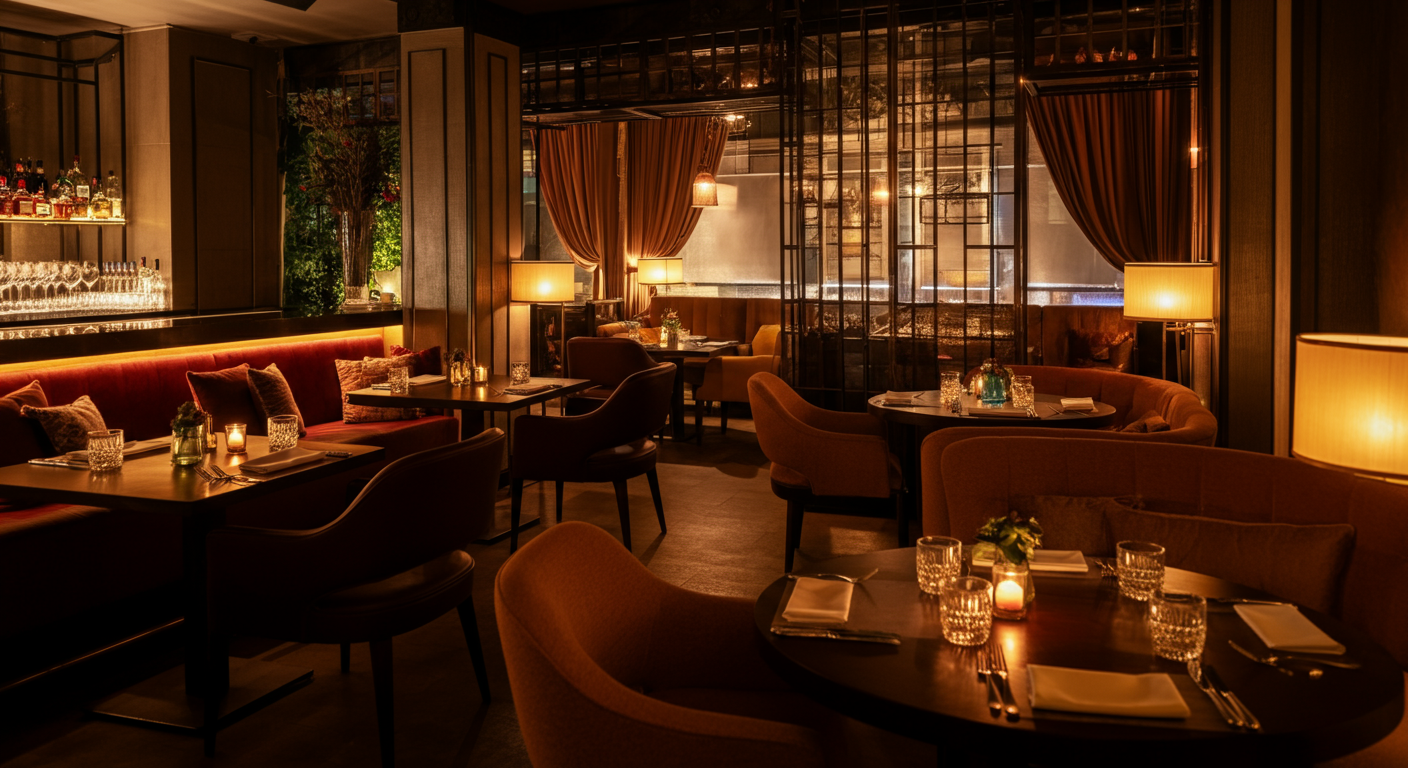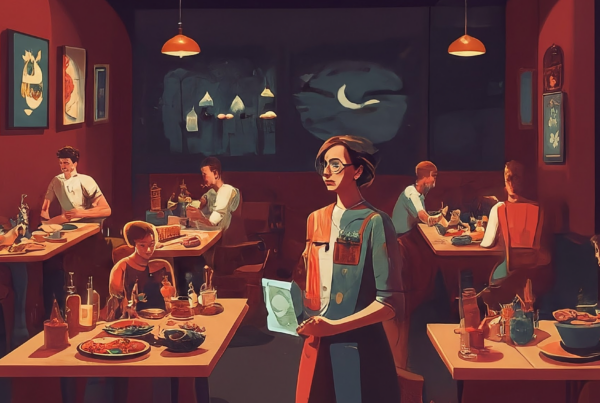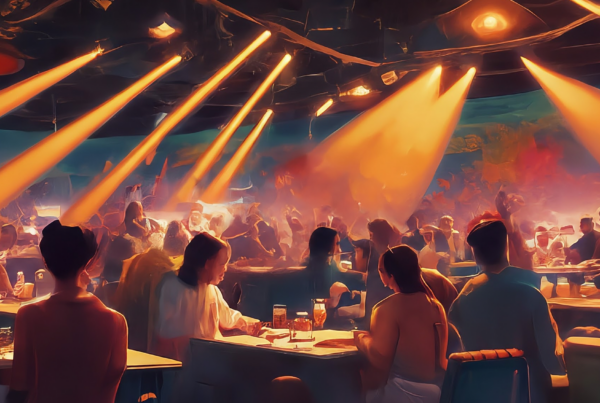Imagine walking into a restaurant where the ambiance captivates you even before the aroma of the food hits your senses. The lights are dimmed just right, the music sets the perfect mood, and the decor tells a story that makes you want to linger longer. This is the magic of creating engaging atmospheres in restaurants, a crucial element that can transform a dining experience from mundane to memorable.
In today’s competitive hospitality industry, crafting such an atmosphere is more than just a nice-to-have; it’s an essential strategy for success. Restaurants that master this art not only attract more customers but also enhance their overall dining experience, encouraging repeat visits and fostering loyalty. As businesses strive to stand out, the ability to create a unique and inviting environment has become a significant differentiator.
Leveraging video content offers a dynamic way to enhance these atmospheres. From showcasing behind-the-scenes kitchen magic to highlighting customer stories and events, video brings an interactive element to the dining space, making it more engaging and enjoyable. This approach not only captivates diners but also serves as a powerful marketing tool, drawing in new patrons through social media shares and word-of-mouth recommendations.
In this article, we’ll explore five innovative ways to utilize video content to create engaging atmospheres in restaurants. You’ll discover strategies that can elevate the dining experience, boost customer retention, and align with trends expected to define 2024. Whether you’re running a cozy cafe or a bustling eatery, these insights will help you craft an environment that leaves a lasting impression on every guest.
So, let’s dive into these creative strategies and see how you can transform your restaurant’s atmosphere into something truly extraordinary.
Leveraging Video Content to Enhance Dining Ambiance
In the competitive world of hospitality, creating an engaging atmosphere in restaurants is essential for attracting and retaining customers. Video content offers a dynamic tool to enhance the dining ambiance, setting the mood and elevating the overall dining experience. By integrating video elements into the restaurant environment, businesses can craft unique and memorable atmospheres that captivate guests and encourage them to return.
Video content can transform a restaurant’s atmosphere by complementing traditional ambiance elements like lighting and music. For instance, strategically placed screens can display calming visuals that align with the restaurant’s theme, such as ocean waves for a seafood restaurant or serene landscapes for a nature-inspired eatery. These visuals can work in tandem with music and lighting to create a cohesive and immersive environment.
Successful Video Integrations in Restaurants
Several restaurants have successfully integrated video content to enhance their ambiance. For example, a high-end sushi restaurant in New York uses video projections of Japanese cherry blossoms to create a tranquil dining experience. This not only enhances the aesthetic appeal but also reinforces the restaurant’s cultural theme, making it a favorite among diners seeking an authentic experience.
Another example is a family-friendly pizzeria that utilizes video content to entertain children with animated short films, allowing parents to enjoy their meals while the kids are engaged. This strategic use of video content caters to the needs of different customer segments, enhancing the overall dining experience and boosting customer satisfaction.
Statistics on Customer Preferences
Research indicates that a significant number of diners appreciate restaurants that incorporate video content as part of their ambiance. According to a study by Coyle Hospitality, 70% of customers reported that video elements positively influenced their dining experience, making them more likely to recommend the restaurant to others. This highlights the potential of video content as a powerful tool for enhancing customer engagement and driving word-of-mouth marketing.
Furthermore, a survey conducted by the National Restaurant Association found that 60% of consumers are more inclined to visit restaurants that offer unique visual experiences. This underscores the importance of leveraging video content to differentiate a restaurant from competitors and create a memorable dining atmosphere.
Case Studies and Examples
One notable case study involves a boutique hotel restaurant that used video content to showcase local art and culture. By displaying videos of local artists and musicians, the restaurant not only supported the community but also enriched the dining experience with a touch of local flavor. This approach resonated with both tourists and locals, enhancing the restaurant’s reputation as a cultural hub.
Another example is a modern bistro that incorporated interactive video tables, allowing diners to explore the menu, view chef recommendations, and even play games while waiting for their meals. This innovative use of video technology not only entertained guests but also streamlined the ordering process, improving operational efficiency.
In conclusion, integrating video content into restaurant atmospheres offers numerous benefits, from enhancing the dining experience to boosting customer engagement. By carefully selecting video elements that align with the restaurant’s theme and customer preferences, businesses can create a unique and inviting environment that leaves a lasting impression on every guest.
Integrating Interactive Video Elements for Customer Engagement
In the evolving landscape of the restaurant industry, creating engaging atmospheres in restaurants has become a pivotal strategy for standing out. One innovative approach is the integration of interactive video elements, which not only captivates diners but also fosters deeper customer engagement. By leveraging technology, restaurants can transform a simple meal into an immersive experience, encouraging patrons to return and share their experiences with others.
Interactive video elements can range from touch-screen menus to augmented reality experiences, each offering unique opportunities to enhance the dining atmosphere. These technologies invite customers to interact with the restaurant environment in novel ways, creating memorable dining experiences that go beyond the traditional. By examining successful implementations and competitor strategies, we can uncover how interactive video can be a game-changer in the hospitality sector.
Benefits of Interactive Video in Restaurants
Interactive video elements offer numerous benefits to restaurants aiming to enhance customer engagement. Firstly, they provide an opportunity for personalized dining experiences. For instance, digital menus can offer tailored recommendations based on customer preferences or dietary restrictions, enhancing satisfaction and encouraging repeat visits. Secondly, interactive videos can serve as educational tools, informing diners about the origins of their food or the chef’s inspiration behind each dish.
Moreover, these elements can significantly reduce perceived wait times. A study by Deloitte found that interactive technologies can improve customer satisfaction by up to 20%, as they keep diners entertained while waiting for their meals. This not only enhances the dining experience but also increases table turnover, benefiting the restaurant’s bottom line.
Examples of Successful Implementations
Several restaurants have successfully integrated interactive video to boost engagement. A notable example is a high-end steakhouse in Chicago that uses augmented reality menus. Diners can scan their menus with a smartphone to see 3D animations of the cooking process, offering a unique glimpse into the kitchen’s artistry. This not only entertains guests but also deepens their appreciation for the culinary craft.
Another example is a family-oriented restaurant chain that employs interactive tablets at each table. These devices allow children to play educational games while waiting for their meals, providing a distraction that parents appreciate. Such implementations demonstrate how interactive video can cater to diverse customer segments, enhancing the overall dining experience.
Competitor Strategies and Insights
Competitors in the hospitality industry are increasingly adopting interactive video to differentiate themselves. According to a report by Technomic, 45% of restaurant operators plan to invest in interactive technology within the next year. This trend underscores the growing recognition of its value in creating engaging atmospheres.
One strategy involves using interactive video walls to display customer-generated content, such as photos or reviews. This not only personalizes the dining experience but also encourages social media sharing, amplifying the restaurant’s reach. Additionally, some establishments are exploring virtual reality dining experiences, where guests can ‘visit’ the farm where their ingredients were sourced, adding an educational and ethical dimension to their meal.
Using Video Content to Showcase Restaurant Identity and Story
In the competitive world of dining, establishing a restaurant’s unique identity is crucial for standing out. Video content offers a dynamic way to convey this identity, allowing restaurants to tell their story in a visually engaging manner. By integrating storytelling techniques and maintaining brand alignment, video content can transform a restaurant’s atmosphere, making it more inviting and memorable for guests.
When done right, video content not only enhances the dining experience but also strengthens the restaurant’s brand presence. It provides an opportunity to connect with customers on a deeper level, inviting them to be part of the restaurant’s journey. Let’s explore how video content can effectively showcase a restaurant’s identity and story.
Crafting a Compelling Narrative
Storytelling is at the heart of using video content to showcase a restaurant’s identity. A well-crafted narrative can evoke emotions and create a lasting impression on diners. Start by identifying the core elements of your restaurant’s story: its origins, mission, and unique selling points. These elements should be woven into the video content to create a cohesive and compelling narrative.
For instance, a farm-to-table restaurant might focus on the journey of its ingredients from local farms to the dining table, highlighting the dedication to sustainability and quality. This not only informs customers about the restaurant’s values but also builds a connection with those who share similar values.
Ensuring Brand Consistency
Maintaining brand consistency is essential when using video content to tell your restaurant’s story. Every element of the video, from the visuals to the music and voiceover, should align with the brand’s identity. This consistency reinforces the restaurant’s image and makes it easily recognizable to customers.
Consider using a consistent color palette, typography, and visual style that mirrors the restaurant’s physical ambiance. For example, a chic urban bistro might use sleek, modern visuals and upbeat music, while a rustic countryside eatery could opt for warm, earthy tones and soothing melodies. This alignment ensures that the video content feels like an extension of the restaurant’s atmosphere.
Examples of Successful Storytelling
Several restaurants have successfully used video content to showcase their identity and story. A notable example is a family-owned Italian trattoria that created a series of videos featuring the family members sharing anecdotes about their culinary heritage. These videos not only highlighted the authenticity of their dishes but also created a personal connection with viewers, inviting them to become part of the family tradition.
Another example is a trendy vegan café that produced a documentary-style video about its commitment to sustainability and ethical sourcing. By featuring interviews with local farmers and footage of the café’s eco-friendly practices, the video resonated with environmentally conscious diners, strengthening the café’s reputation as a leader in sustainable dining.
Incorporating video content into your restaurant’s marketing strategy can significantly enhance its identity and story. By crafting a compelling narrative, ensuring brand consistency, and drawing inspiration from successful examples, restaurants can create engaging atmospheres that captivate diners and foster loyalty.
Enhancing Atmospheres with Video: Key Takeaways
In the dynamic world of hospitality, creating engaging atmospheres in restaurants is a pivotal strategy for attracting and retaining customers. As we’ve explored, leveraging video content is an innovative and effective way to transform the dining experience. By integrating video into the restaurant environment, businesses can craft unique and memorable atmospheres that captivate guests and encourage them to return.
Several key strategies can be employed to harness the power of video content in restaurants:
- Interactive Video Elements: Incorporate technologies like touch-screen menus and augmented reality to enhance customer engagement and create immersive dining experiences.
- Showcasing Restaurant Identity: Use video to tell your restaurant’s story, ensuring brand alignment and connecting with customers on a deeper level.
- Customer Engagement: Utilize video to entertain and educate diners, reducing perceived wait times and improving satisfaction.
The benefits of these strategies are clear. Video content not only enhances the dining experience but also serves as a powerful marketing tool, helping restaurants differentiate themselves in a competitive market. According to a study by Coyle Hospitality, 70% of customers reported that video elements positively influenced their dining experience, highlighting the potential of video as a tool for enhancing customer engagement.
As you consider implementing these strategies, remember that the key to success lies in aligning video content with your restaurant’s unique theme and customer preferences. This approach not only creates a cohesive atmosphere but also leaves a lasting impression on diners.
Ready to transform your restaurant’s atmosphere and boost customer engagement? Explore more about video content strategies and discover how DLM Media can help you achieve your goals. Visit our website for more insights and expert guidance.





